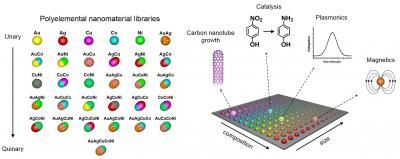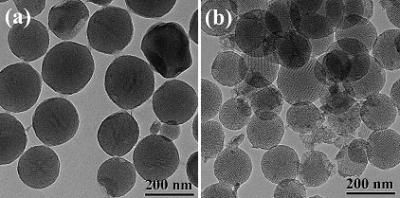Research explores interactions between nanomaterials, biological systems
The recent explosion in the development of nanomaterials with enhanced performance characteristics for use in commercial and medical applications has increased the likelihood of people coming into direct contact with these materials.
There are currently more than 800 products on the market - including clothes, skin lotions and cleaning products - claiming to have at least one nanocomponent, and therapeutic nanocarriers have been designed for targeted drug delivery inside the human body. Human exposure to nanomaterials, which are smaller than one one-thousandth the diameter of a human hair, raises some important questions, including whether these "nano-bio" interactions could have adverse health effects.
Now, researchers at UCLA and the California NanoSystems Institute (CNSI), along with colleagues in academia and industry, have taken a proactive role in examining the current understanding of the nano-bio interface to identify the potential risks of engineered nanomaterials and to explore design methods that will lead to safer and more effective nanoparticles for use in a variety of treatments and products.
In a research review published in the July issue of the journal Nature Materials (and currently available online), the team provides a comprehensive overview of current knowledge on the physical and chemical properties of nanomaterials that allow them to undergo interactions with biological molecules and bioprocesses.
"What we have established here is a blueprint that will serve to educate the first generation of nanobiologists," said Dr. Andre Nel, leader of the team and chief of the division of nanomedicine at the David Geffen School of Medicine at UCLA and the California NanoSystems Institute.
Despite remarkable advances in nanoscience, relatively little is known about the intracellular activity and function of engineered nanomaterials, an area of study particularly important for the development of effective and safe nanoparticle drug-delivery systems. Much of the current knowledge derives from the study of tagged or labeled nanoparticles and their effects on cells after cellular uptake - without any detailed understanding of what these interactions may lead to, good or bad.
The review article examines the variety of ways in which nanomaterials interface with biological systems and presents a roadmap of the physical and chemical properties of the materials that could lead to potentially hazardous or advantageous interactions at the nano-bio interface. A better understanding of the biological impact, combined with appropriate stewardship, will allow for more informed decisions about design features for the safe use of nanotechnology.
In addition to Nel, the team included Tian Xia, a researcher in UCLA's nanomedicine division, UCLA associate professor of civil and environmental engineering Eric Hoek, Lutz Mädler of the University of Bremen, Darrell Velegol of Penn State University, Ponisseril Somasundaran of Columbia University, Fred Klessig of Pennsylvania Bio Systems, Vince Castranova of the National Institute for Occupational Safety and Health, and Mike Thompson of FEI Co.
"We are committed to ensuring that nanotechnology is introduced and implemented in a responsible and safe manner," said Nel, who also directs the Center for Environmental Implications of Nanotechnology, which is funded by the National Science Foundation and the Environmental Protection Agency and is headquartered at the CNSI.
"Based on our rapidly improving understanding of nano-bio interactions, we have done a thorough examination of the literature and our own research progress to identify measures that could be taken for safe design of nanomaterials," he said. "Not only will this improve the implementation and acceptance of this technology, but it will also provide the cornerstone of developing new and improved nanoscale therapeutic devices, such as drug-delivering nanoparticles."
The review article spotlighted several important research advancements:
- A classification of the interactions when nanomaterials contact and bind to biological systems will help scientists understand how man-made materials may react when exposed to cells, tissues and various life forms in different natural environmental contexts.
- When nanomaterials enter a biological fluid - for example, blood, plasma or interstitial fluid - the materials' surface may be coated with proteins. Understanding how these protein layers change the properties of the nanomaterials and the ways in which they interact in the body can provide valuable information on how to alter the protein coatings to allow for targeted delivery of nanomaterials to specific tissues, such as in cancer treatments.
- Physicochemical properties such as size, charge, shape and other characteristics could greatly affect the ability of nanomaterials to enter a cell; this could determine whether a material can be useful in nanomedicine applications or could cause harm if taken in by life forms in an ecosystem or food chain.
- Nanoparticles can elicit a wide range of intracellular responses, depending on their properties, concentrations and interactions with biological molecules. These properties and their relationships to cellular function can induce cellular damage or induce advantageous cellular responses, such as increased energy production and growth.
Based on the link between certain nanomaterial properties and potential toxic effects, the team asserts that scientists can reengineer specific nanomaterial properties that are hazardous while maintaining catalytically useful function for industrial use.
As an example of a safe design feature, some nanoparticles now receive a surface coating designed to improve safety by preventing bioreactivity. Nanoparticles in cosmetic formulations such as suntan lotions, for instance, may be coated with a water-repelling polymer to reduce direct contact with human skin. An extension of this principle uses polymers and detergents to decrease cellular uptake. However, there is the potential that when the coating wears off, the material may become hazardous. It is therefore important to consider improving the stability of coating substances. Coating nanoparticles with protective shells is also an effective means of preventing the breakup of materials that could release toxic substances upon dissolution.
"Instead of waiting for knowledge to unfold randomly, we can already begin to view the events at nano-bio interface as a discoverable scientific platform that can be used for setting up a deliberate inorganic-organic roadmap to new, better and safer products," Nel said. "What we can identify by understanding the rules that shape the nano-bio interface will have a massive impact on the ability to develop safe nanomaterials in the future."






























































